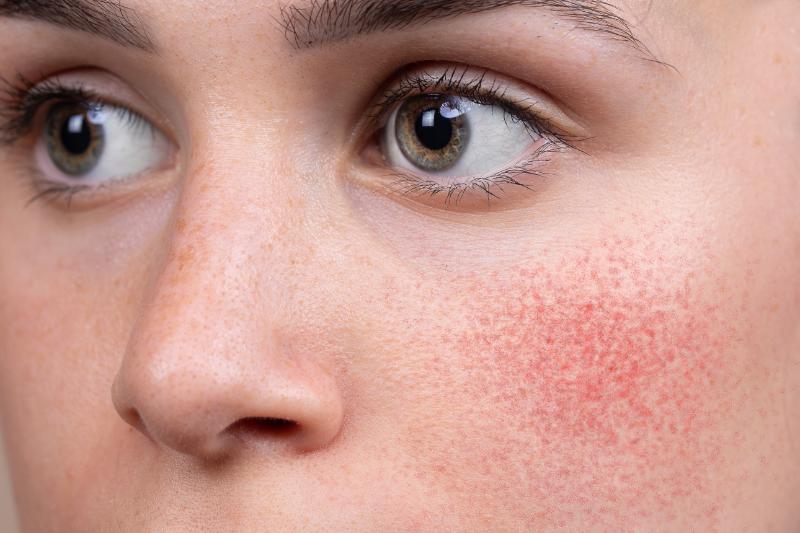Rosacea is a chronic skin condition characterized by facial redness, visible blood vessels, and in some cases, pimple-like bumps. It is among the most prevalent skin conditions impacting people of all age groups. In the United States alone, over 16 million people deal with its effects, underscoring the broad scope of its impact.
Rosacea is characterized by a distinctive skin outbreak that causes a persistent redness, typically concentrated around the central facial areas, including the nose, cheeks, chin, and forehead. While the condition may often appear like an intense blush, it can also lead to the formation of small, red, pus-filled bumps on the skin.
At Robertson Pediatrics, we recognize that rosacea is a condition that can lead to self-consciousness, irritation, and discomfort. We specialize in caring for young patients with rosacea, ensuring they receive the personalized attention and treatment they need.
Rosacea is a multifaceted skin condition, and its immediate cause is still under research. However, several factors have been identified as potential contributors to rosacea.
One of the leading factors behind childhood rosacea is genetic predisposition. If there is a family history of rosacea, a child may be at a higher risk of developing the condition. Genetic factors can impact how the skin responds to various triggers and the likelihood of developing rosacea.
Environmental factors are known to play a significant role in triggering and aggravating rosacea symptoms in children.
- Prolonged sun exposure and exposure to harsh UV rays can trigger rosacea flare-ups. UV rays can lead to skin inflammation and worsen the condition, making sun protection a necessary step.
- Spicy foods, hot beverages, and alcohol are common triggers for rosacea. These substances can lead to flushing and increased redness in the affected areas.
- Cold, windy weather can be particularly harsh on sensitive skin, leading to increased redness and irritation.
The immune system's response to various environmental factors and stressors may also contribute to the development of rosacea.
In children with an overactive immune system, the body's response to certain triggers may lead to increased skin inflammation and the onset of rosacea symptoms.
While hormonal factors are less common in children, they can influence the condition, especially as children go through puberty. Hormonal fluctuations can impact the skin's oil production and trigger rosacea symptoms.
Symptoms of rosacea can include:
- Facial Redness: One of the hallmark signs of childhood rosacea is persistent facial redness. This redness typically affects the central areas of the face, including the nose, cheeks, chin, and forehead. It's not the same as a temporary blush and can be more intense and long-lasting.
- Flushing: Children with rosacea may experience frequent flushing episodes. These episodes involve sudden and noticeable reddening of the skin, often triggered by factors like heat, spicy foods, or stress.
- Pimple-like Bumps: While childhood rosacea rarely involves comedones (whiteheads and blackheads), it can lead to the development of pimple-like bumps. These bumps may appear as small, red, and pus-filled papules.
- Visible Blood Vessels: In addition to redness and pimple-like bumps, rosacea often results in the visibility of small blood vessels on the skin's surface. These vessels may appear as fine red lines or patterns, contributing to the overall redness and skin texture.
- Related Eye Issues: In more severe cases of childhood rosacea, the condition may influence the eyes, causing eye irritation, dryness, and redness. It is essential for parents and caregivers to be aware of this potential eye involvement and seek medical attention if their child experiences eye symptoms.
Although rosacea and some forms of acne may look similar, they are medically different from each other. Some characteristic differences between the two include:
- Absence of Comedones: A key difference with rosacea is the absence of comedones, such as whiteheads and blackheads, which are common in acne. In rosacea, these types of blemishes are typically rare.
- Location on the Body: Rosacea typically appears only on the face area. However, acne may appear on any part of the body.
- Persistent Redness: Rosacea is characterized by persistent facial redness, which is not a typical feature of acne. This redness is often concentrated on the central areas of the face and can be a constant concern for children with rosacea.
- Visible Blood Vessels: The presence of visible blood vessels on the skin's surface is a distinctive feature of rosacea. Acne, on the other hand, does not typically result in such visible vascular patterns.
Understanding these differences can help identify childhood rosacea correctly. Accurate identification enables parents, caregivers, and healthcare professionals to provide appropriate care and treatment tailored to the specific needs of children with rosacea.
A precise diagnosis of rosacea is important to ensure that your child receives the appropriate care and support. Diagnosis is usually made based on an examination of the skin for common symptoms and potential eye involvement.
The doctor may also perform tests to rule out more common childhood conditions that can resemble rosacea, including acne, skin infections, and allergic skin reactions.
At Robertson Pediatrics, once a diagnosis of childhood rosacea is confirmed, a tailored treatment plan is devised for your child.
Identifying Triggers
It is crucial to identify and avoid triggers to manage your child’s rosacea. Common triggers during childhood include exposure to extreme temperatures, consumption of hot beverages, intake of spicy foods, and the use of skincare products containing fragrances. However, these triggers may differ from one child to another.
Using Sun Protection
We recommend applying sunscreen daily before your child goes outdoors to safeguard their sensitive skin. It's essential to use sunscreen that meets specific criteria:
- Contains titanium oxide, zinc oxide, or both.
- Displays "broad-spectrum," "water-resistant," and "SPF 30" or higher on the container.
- Is fragrance-free to minimize skin irritation.
Avoiding Irritants
Some skincare products may contain ingredients that irritate sensitive skin. Before using any product on your child's skin, read the list of ingredients carefully. Children with rosacea should steer clear of products containing sodium lauryl sulfate (often found in shampoo and toothpaste), menthol, or camphor.
Medication
Your doctor may prescribe both topical and oral medications to treat childhood rosacea based on the severity of the condition.
For mild to moderate rosacea, a topical medication called metronidazole is commonly prescribed. In severe cases, an antibiotic may be prescribed to manage symptoms.
Antibiotics may also be used to treat rosacea in the eyes.
Setting Up Follow-up Appointments
Some children may respond well to one treatment but not another, and adjustments to the treatment plan may be needed, based on response. Remember to set up a follow-up appointment as per your doctor’s advice.
You can minimize flare-ups for your child by following some simple prevention strategies:
- Use sun protection. Shielding your child from the sun's harsh rays is essential. Dermatologists recommend applying sunscreen daily, especially on the face, ears, and hands, before your child heads outdoors. Choose a broad-spectrum sunscreen that’s water-resistant and has an SPF of 30 or higher. Opt for fragrance-free sunscreen to reduce the risk of skin irritation.
- Make dietary modifications. Some common triggers for rosacea in childhood include consuming hot beverages, spicy foods, and exposure to extreme temperatures. Making dietary modifications and avoiding environmental triggers can help reduce the frequency and severity of flare-ups.
- Employ stress reduction strategies. Stress can exacerbate rosacea symptoms, so it's important to help your child manage stress. Always remember that a supportive environment at home can go a long way in helping your child cope with the emotional challenges that can accompany rosacea.
Rosacea in children is a challenging condition, but with early intervention and proper care, children can lead healthy, confident lives. Robertson Pediatrics can support you and your child on this journey to manage childhood rosacea effectively.
We will work with you to find the best treatment for your child’s skin! For appointments, please call Robertson Pediatrics at 310-659-8687 or contact us online.


